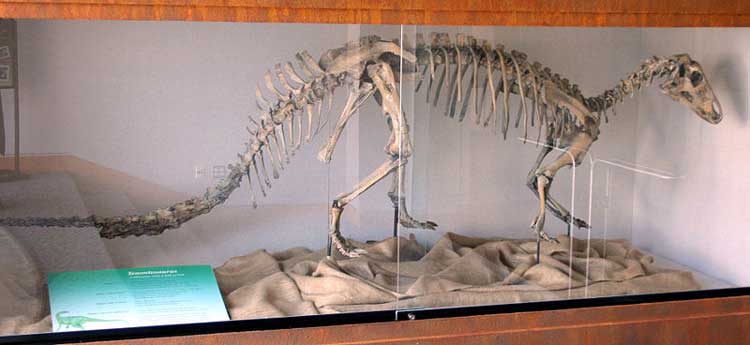Tenontosaurus skeleton, North Carolina Museum of Natural Sciences. (*)
Tenontosaurus (pronounced /tɨˌnɒntəˈsɔrəs/ ten-ON-toe-SORE-us) is a genus of medium- to large-sized ornithopod dinosaur. It was formerly thought to be a 'hypsilophodont', but since Hypsilophodontia is no longer considered a clade, it is now considered to be a very primitive iguanodont. Anatomy The presence of medullary bone tissue in the thigh bone and shin bone of one specimen indicates that tenontosaurs used this tissue, today only found in birds that are laying eggs, in reproduction. Additionally, like Tyrannosaurus and Allosaurus, two other dinosaurs known to have produced medullary bone, the tenontosaur individual was not at full adult size upon her death at 8 years old. Because the theropod line of dinosaurs that includes Allosaurus and Tyrannosaurus diverged from the line that led to Tenontosaurus very early in the evolution of dinosaurs, this suggests that dinosaurs in general produced medullary tissue and reached reproductive maturity before maximum size.[1]
Tenontosaurus tilletti (*) Discovery and species The genus contains two species, Tenontosaurus tilletti (described by John Ostrom in 1970) and Tenontosaurus dossi (described by Winkler, Murray, and Jacobs in 1997). Many specimens of T. tilletti have been collected from the Cloverly Formation of Wyoming and Montana, and from the Antlers Formation of southern Oklahoma. T. dossi is known from only a handful of specimens collected from the Twin Mountains Formation of Parker County, Texas. Fossil evidence Deinonychus teeth and a number of skeletons were discovered associated with Tenontosaurus tilletti specimens, implying that this dinosaur was hunted and/or scavenged by Deinonychus.[2][3][4] References 1. ^ Lee, Andrew H.; and Werning, Sarah (2008). "Sexual maturity in growing dinosaurs does not fit reptilian growth models". Proceedings of the National Academy of Sciences 105 (2): 582–587. doi:10.1073/pnas.0708903105.
Retrieved from "http://en.wikipedia.org/" |
|


